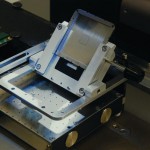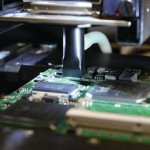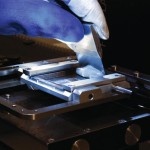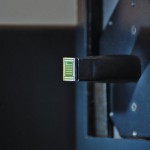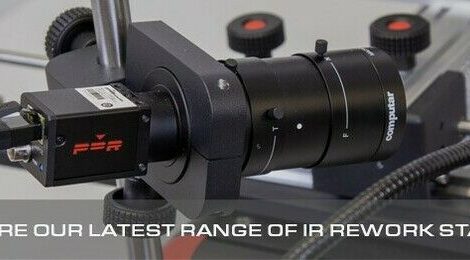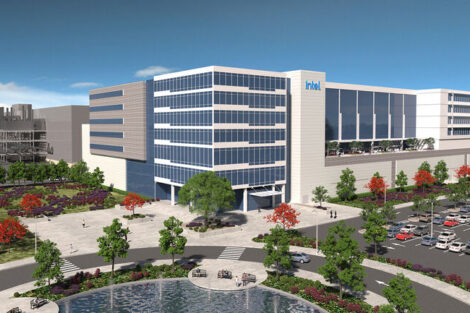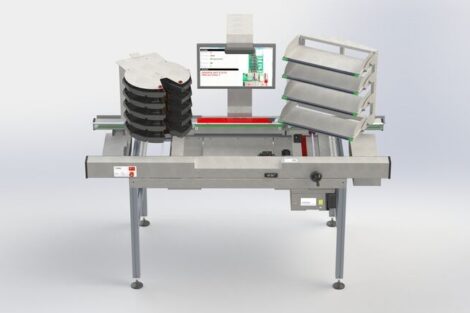Finetech customers around the world have successfully reworked QFN components with the Direct Component Printing(DCP) module. Their feedback and suggestions from productive use were the starting point for the development of the module’s next generation. As a result, handling the DCP Module is now easier than ever while print performance and output could be increased.
Finetech, Berlin (Germany)
Minimum space requirements and outstanding electric and thermal capacities make QFN, MLF and similar SMD components a preferred choice especially for mobile device PCB. Besides numerous benefits, however, one significant critical point remains: rework of such „leadless components“ is much more of a challenge compared to other SMD types as the following facts make clear:
- The flat design without solder deposit (unlike BGA, i.e.) requires an external solder application solution.
- The trend is toward fine pitch QFN which calls for a highly precise and stable application of solder material.
- QFN with power pads used for heat dissipation and electrical connection make particular demands to the de-soldering process, especially if the component is to be re-used.
- Commonly, QFN components can be found on densely populated PCB with limited or no access at all for paste printing heads and the likes.
- According to IPC/JEDEC QFN components are specified for a maximum of only three reflow cycles.
- In order to protect the sensitive print layout a careful vacuum-controlled component handling is a necessity.
In a nutshell, an efficient QFN rework needs to cope with two key challenges. The first is to find a solution how to apply solder onto the com-ponent. And the second is to integrate the solution into a rework system which has the capabilities in terms of alignment and placement accuracy, ESD-safe component handling, coordinated thermal management and process repeatability. With the Direct Component Printing module the company has offered a smart retrofit solution for Fineplacer rework systems for over 5 years.
Integrated QFN rework solution
The DCP Module allows manual application of fresh solder material onto a QFN component through a printing stencil. As the DCP module is integrated into the rework system the component is handled exclusively by the system’s positioning table and soldering arm. The patented Fineplacer Vision Alignment System is used to align the component to the printing stencil and later to the substrate with up to 5 micron accuracy. All process steps of the QFN rework cycle such as de-soldering, residual solder removal, site dressing, fluxing, QFN printing, optical inspection of the print layout, alignment, placement and soldering, can be performed on the same rework system.
Finetech customers around the world have successfully reworked QFN components with the Direct Component Printing module. Their experiences and suggestions from productive use were the starting point for a number of innovations which form the DCP module’s next generation.
One essential innovation target for the improved version was to increase reliability and efficiency when working on fine pitch applications. The company identified that this could be achieved by stabilizing the print layout with an optimized printing stencil design while at the same time making it easier and faster to operate the DCP module, hence increasing the actual throughput.
Improved stencil design
For the development of an improved printing stencil version the company partnered with LaserJob from Augsburg, a qualified German manufacturer of innovative high-quality stencil technology. LaserJob was able to design and provide tailor-made stencils according to the component’s specifications with laser cut openings allowing for a precise and dosed solder application. Even 400 micron fine pitch QFN components are no problem. Optionally, the printing stencils come with a special nano-coating for improved solder removal, easy cleansing, better wear protection and longer system life between stencil changes. As opposed to the previous solution, printing stencil and clamping frame are now non-detachably connected to one another. Similar to component manufacturing technologies with inline printers the clamping frame significantly improved mechanical stability even of ultra thin fine pitch stencils. The structural unit of stencil and frame allow switching between stencils very quickly as tools are no longer needed. With reduced changeover times the output can be drastically improved, especially when reworking different types of QFN. The new stencils are 100% compatible with the previous DCP module so existing DCP customers can benefit from the improvements, too.
Summary
By offering an uncomplicated high-precision component solder printing solution through laser cut stencils the DCP module provides the benefit of reworking QFN and MLF components with one rework cycle. When combined with the numerous benefits of a Fineplacer rework station – perfect thermal management with hot air and optional process gas integration, visual precision alignment of component and substrate, ESD-proof component handling – it guarantees a rework in OEM quality. It is the only reliable QFN rework solution in the market which allows a correction of misplaced QFN and is in compliance with IPC/JEDEC specifications limiting the number of valid reflow processes to three. The range of previous and subsequent rework steps are seamlessly integrated into the process sequence. The whole rework cycle can be performed on the same rework system. Experience a live QFN rework demonstration with the new generation of the DCP module at the upcoming show.
SMT Hybrid Packaging
Booth 6-406
Zusammenfassung
Gesammelte praktische Erfahrungen bilden die Grundlage der neuen Generation des Direct Component Printing zur Reparatur von QFNs. Im Ergebnis ist das Handling des DCP-Moduls einfacher bei konstant hoher Druckqualität und gesteigertem Durchsatz.
Des expériences pratiques collectées constituent la la base de la nouvelle génération du Direct Component Printing pour la réparation de QFNs. Au résultat, la manipulation du module DCP est plus simple avec une grande qualité d’impression constante et des performances en hausse.
Share:




